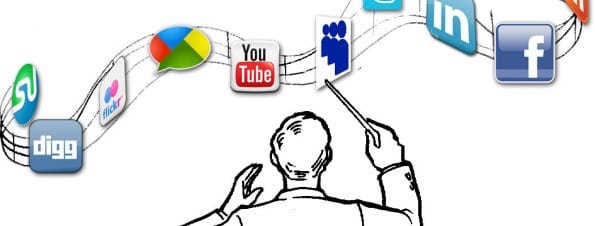The purpose of this article is to explain the social media adoption curve, the growth of the internet as a whole, and to help you understand how it will all affect the American political machine moving forward.
A Brief History of Social Media
Social media is a broad term. Social media websites are quickly becoming the communication hubs for new, digital nations. Nations which are forming all around us right now, without borders or geographic reach. Places where people can come together to interact and engage each other freely, share ideas, and gossip about life.
They have become real time forums for exchanging information, pictures, status updates and even piddly little arguments. And let’s not forget the amount of business that is transacted on the internet each year. They have become a large part of our pop culture and a primary means for the majority of internet users to interact with each other, even from across the globe.
The question then becomes, what will the next evolution of technology and social communication look like, and how will it affect the world around you? And more specifically, for the purpose of this article, how it could affect the next major American election cycle.
As web technology evolves, and the web becomes more interactive, it becomes easier and easier for the average person to get involved and make an impact. For some punk kid like me to come out of nowhere, and reach an audience that was only possible as part of a big boy media network.
This evolution of technology and innovation is empowering the creative class like never before, and it does’t mean that the big boys are going away anytime soon, but it does open the doors for a digital revolution. But for now, back to the topic at hand.
Social Media Adoption Timeline
In order to truly understand the speed at which everything is moving, let’s look at the major milestones in the timeline of social media development over the last 20 years. For more social media stats, click here.
1994
- More than 1,500 Web servers were online in 1994 and people were referring to the Internet as the Information Superhighway.
1995
1997
- The Web had one million sites.
- Blogging begins.
- AOL Instant Messenger lets users chat.
1998
- Google opens as a major Internet search engine and index.
2000
- In the world of business and commerce, the dot.com bubble burst and the future online seemed bleak as the millennium turned.
- Seventy million computers were connected to the Internet.
2001
- Wikipedia, the online encyclopedia and world’s largest wiki, was started.
- This is also the time Apple started selling iPods.
2002
- Friendster, a social networking website, was opened to the public in the U.S. and grew to 3 million users in three months.
- AOL had 34 million members.
2003
- MySpace. another social networking website, was launched as a clone of Friendster.
- Linden Lab opened the virtual world Second Life on the Internet.
- LinkedIn was started as a business-oriented social networking site for professionals.
- There were more than 3 billion Web pages.
- Apple introduced the online music service iTunes.
2004
- Facebook, another social networking website, was started for students at Harvard College. It was referred to at the time as a college version of Friendster.
- MySpace surpassed Friendster in page views.
- Podcasting began on the Internet.
- Flickr image hosting website opened.
- Digg was founded as a social news website where people shared stories found across the Internet.
2005
- News Corporation, buys MySpace.
- YouTube began storing and retrieving videos.
- There were more than 8 billion Web pages.
2006
- MySpace was the most popular but Facebook would take away that lead later, in 2008.
- Twitter was launched
- Facebook membership was expanded and opened to anyone over age 13.
- Google had indexed more than 25 billion web pages, 400 million queries per day, 1.3 billion images, and more than a billion Usenet messages.
2007
- Microsoft bought a stake in Facebook.
- Apple released the iPhone multimedia and Internet smartphone.
2008
- Facebook surpassed MySpace in the total number of monthly unique visitors. Meanwhile, Facebook tried unsuccessfully to buy Twitter.
2009
- Facebook ranked as the most-used social network worldwide with more than 200 million. The site’s traffic was twice that of MySpace.
- Unfriend was the New Oxford American Dictionary word of the year.
- By this time It’s estimated that a quarter of Earth’s population used the Internet.
- Google saw one trillion unique URLs — after eliminating duplicate entries.
- The Internet had at least 27 billion web pages and could have had as many as 58 billion web pages. They changed so many times a day it was nearly impossible to count.
2010
- Facebook’s rapid growth moved it above 400 million users,
- Apple released the iPad tablet
- The Democratic National Committee advertised for a social networks manager to oversee President Barack Obama’s accounts on Facebook, Twitter and MySpace.
- It was estimated the population of Internet users was 1.97 billion. That was almost 30 percent of the global population.
- This was also the first time the Internet had surpassed newspapers as a primary way for Americans to get news,
2011
- more than 550 million people on Facebook, 65 million tweets sent through Twitter each day, and 2 billion video views every day on YouTube. LinkedIn has 90 million professional users.
- Public sharing of so much personal information via social media sites raised concern over privacy.
- It was estimated Internet users would double by 2015 to a global total of some four billion users, or nearly 60 percent of Earth’s population.
2012
- Some 2 billion people around the world use the Internet and social media, while 213 million Americans use the Internet via computers while 52 million use the Web via smartphone and 55 million use it via tablets.
- People also connect to the Internet via handheld music players, game consoles, Internet-enabled TVs and e-readers.
- The top ten social networks are Facebook, Blogger, Twitter, WordPress, LinkedIn, Pinterest, Google+, Tumblr, MySpace and Wikipedia.
- More than half of adults 25-34 use social media at the office. Almost a third of young adults 18-24 use social media in the bathroom. All use social networks to stay connected with acquaintances, be informed and be amused.
- Advertisers look to social “likes” to enhance brand visibility.
- Facebook reached a billion users in 2012.
The Age of You Tube:
- YouTube has more than 800 million users each month with more than 1 trillion views per year or around 140 views for every person on Earth.
- Seventy percent of YouTube traffic comes from outside the U.S.
- YouTube is local in 43 countries and uses 60 languages.
- 72 hours of video are uploaded to YouTube every minute with more than 4 billion hours of video watched each month on YouTube.
2013
- YouTube topped one billion monthly users with 4 billion views per day
- Facebook user total climbed to 1.11 billion. 200% growth in 2 years
- Twitter had 500 million registered users, with more than 200 million active.
- LinkedIn had 225 million users, while MySpace had 25 million users.
- Pinterest had 48.7 million users, while WordPress hosted 74 million blogs.
- Dropbox had more than 100 million users with 1 billion files uploaded daily.
- Google+ had 343 million users.
- Reddit had 69.9 million monthly users, with 4.8 billion monthly page views.
- There were 156 million blogs. Blogs, online videos and podcasts continue to be staples for marketers.
Where do people use social media?
An Australian survey found that as a percentage, social network users logged on…
- 34% at work
- 13% at school
- 18% in the car
- 44% in bed
- 7% in the bathroom
- 6% on the toilet.
Social Networking Fact Sheet
Highlights of the Pew Internet Project’s research related to social networking.
Click here for a link to a current version of these stats and the source for this graphic.
As of September 2013 — 73% of online adults use social networking sites
- 71% of online adults use Facebook
- 18% of online adults use Twitter
- 17% use Instagram
- 21% use Pinterest
- 22% use LinkedIn
In May 2013, 74% of women were users of social networking sites, compared with 62% of men.

For a detailed demographic portrait of users of various social networking sites please see this recent report, Social Media Update 2013.
Early Adopters & Growth Curve
It is not hard to guess that the earliest of adopters were the 18-29 age segment which is made up mostly of millennials.
Between February 2005 and August 2006, the use of social networking sites among young adult internet users ages 18-29 jumped from 9% to 49%. Social networking site use by age group, over time:
As it stands now, the total percentage of 18-24 year olds who already use social media is at 98%

Mobile Adoption
As social networking sites grow and evolve, so do the means of accessing them.
Mobile phones are quickly replacing desktops and laptops as the primary means of accessing the internet as well as interacting with social media applications. Native iPhone and Android apps make up a large part of direct traffic to each of the major social networks, and many are starting to design their entire experiences with mobile as their number one priority.
A battle for eyeballs which is taking place right in front of our eyes.
40% of cell phone owners use a social networking sites on their phone, and 28% do so on a typical day.
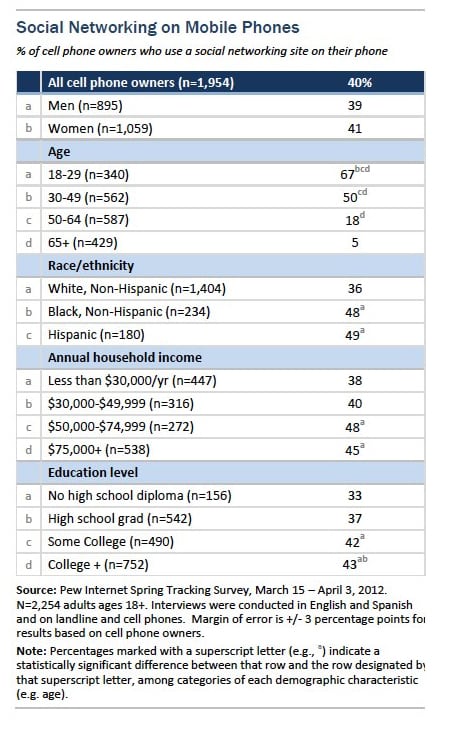
Holy shit! That’s some social growth!
Social media is upon us in full force. Furthermore, as trends continue to develop social media will evolve and become a larger piece of the entire internet culture.
As websites begin to implement more social features and developers find ways to make the process of building social websites easier for the average person, you will see an almost imminent adoption of niche style social networks built around small, targeted interests.
“Instead of lobbying happening in the back rooms in Washington, it will take place all around us.”
Privacy concerns will continue to grow, and security will become an even more important part of our daily internet activity.
Masses will flock to seek shelter from spying governments and over powered online collectors of information such as Google and Facebook.
We are on the precipice of a new economic explosion. One where information dictates your status in society and your ability to control and manage your digital presence is becoming something we all need to worry about.
From here forward, I’ll be explaining some of my theories on how all this information will come together in the future, to help you understand the progression of social media and the effect it will have on our entire political system.
Voter demographics
Who votes?
Social media is good for online discourse, but in the real world. people who show up have all the power. Something that social media has failed to replicate. At least for now.
That being said, lets look at some voter demographics and find out if the same people that are using social media are actually voting and what conclusions we can draw based on the growth trends of social media and the voter turnout trends over the last 20 years.
Voter turn out by age
This is a chart illustrating voter turnout by sex and age for the 2008 US Presidential Election. The source is the U.S. Census Bureau. I used the 2008 election because it was the highest voter turnout in the last decade. It also represents the last election before mass adoption of social media and as we discussed already, there were massive disparities between the two sides of the political aisle and their social media adoption rates. Disparities that have grown exponentially since the 2008 election.

Voter Registration vs. Turnout by Age
This chart takes a look at voter registration, turnout, and turnout-of-registered trends across the past four presidential elections in the United States: 1996, 2000, 2004, and 2008. The data come from the Current Population Survey and are smoothed to reduce the variability across age due to survey sampling. — source
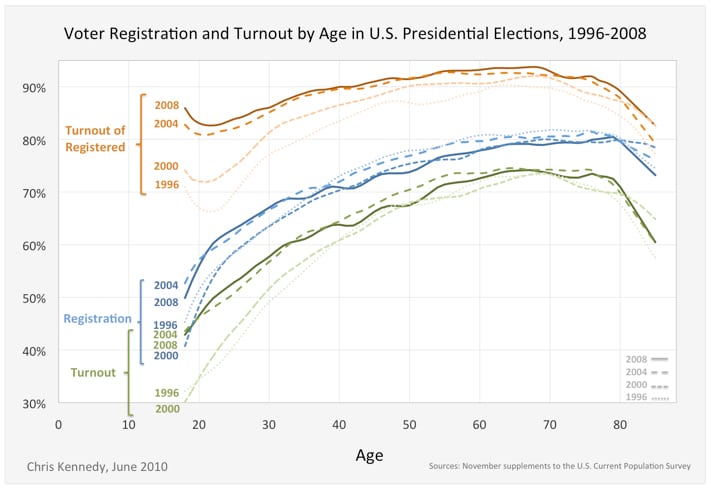
Voter turn out year over year
A comparison of year over year voter turnout over the last 18 years. The bold text indicates it was a presidential election year.
| YEAR | VOTING-AGE
POPULATION | VOTER
REGISTRATION | VOTER TURNOUT | TURNOUT OF VOTING-AGE
POPULATION (PERCENT) |
|---|
| 2012 | 240,926,957 | NA | 130,234,600 | 57.5 |
| 2010 | 235,809,266 | NA | 90,682,968 | 37.8 |
| 2008 | 231,229,580 | NA | 132,618,580* | 62.3 |
| 2006 | 220,600,000 | 135,889,600 | 80,588,000 | 37.1 |
| 2004 | 221,256,931 | 174,800,000 | 122,294,978 | 60.4 |
| 2002 | 215,473,000 | 150,990,598 | 79,830,119 | 37.0 |
| 2000 | 205,815,000 | 156,421,311 | 105,586,274 | 51.3 |
| 1998 | 200,929,000 | 141,850,558 | 73,117,022 | 36.4 |
| 1996 | 196,511,000 | 146,211,960 | 96,456,345 | 49.1 |
| 1994 | 193,650,000 | 130,292,822 | 75,105,860 | 38.8 |
Read more about these numbers: National Voter Turnout in Federal Elections: 1960–2010 | Infoplease.com https://www.infoplease.com/ipa/A0781453.html#ixzz2x0wTNOtb
There was a substantial drop in voter turnout from the 2004 and 2008 elections which is interesting because this correlates with a massive increase in the social media timeline. You can also look at the difference between social media presence between Mitt Romney and President Barack Obama. Obama had Romney beat by a substantial margin which might have helped demoralize the republicans and decreased their excitement to even vote, feeling that the election was out of their hands already.
I feel like this more than anything was the value of social media in the last few elections. They served more as a demoralization engine, making the other party believe they had already lost. Leave out the arguments about the weak candidates as that theory only increases the effectiveness of poor social strategies. President Obama and the Democrat Party used Social Media flawlessly since its inception and there is much to be learned from them. More than I could ever cover in this short report.
Much like the mainstream media, social media will have to be mastered by any politician hoping to compete on a national stage moving forward. A shift that will leave some of the existing political class a little exposed and scrambling for help on their campaign teams.
Voter confidence levels
Do people still believe in their elected officials?
The american people are absolutely fed up with the federal government. With an insatiable thirst for power and an inability to spend within their means the United States Government has completely lost touch with its citizens and the voter turnouts reflect their lack of confidence. Voter apathy and overall engagement are down because the Amreican people have been beaten into thinking that nothing they do matters. All the decisions are to be made in Washington and the people be damned.
Presidential approval ratings are down, congressional approval ratings are down and most Americans would be ok with throwing all of Washington DC out on their asses. How come no one is talking about term limits for everyone? How come no one is talking about anything drastically different than what we have done to get us up to this point.
No matter how social politics gets, there is no changing anything until engagement and political education as a whole increase across America.
Presidential approval rating over the last 4 years
In this next chart, you can see the timeline of voter confidence in President Barack Obama as determined by ABC’s Voter Confidence Index.
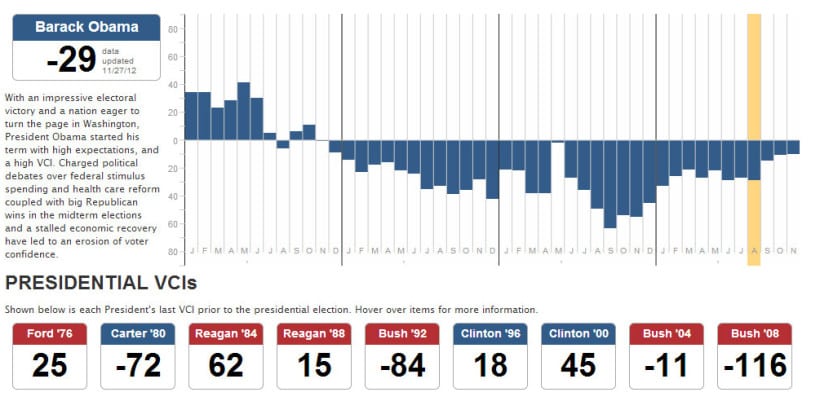
Congressional approval rating over the last 5 years
This chart shows congressional approval ratings since 2009. The highest they have been at any point since then is 39% which is disgusting in and of itself, even if you do not take into consideration the current low of 13% and the all time low of 9% congressional approval which we set at the end of 2013.
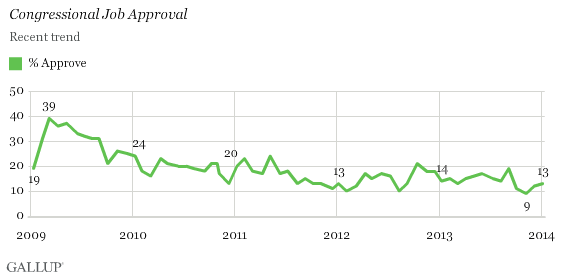
The American People Are Just Fed Up and Tuned Out
The overwhelming majority of America feels that their voice is not making a difference and they have completely tuned out. They are made to feel like they cant make a difference which then creates a self fulfilling prophecy.
By looking at the charts of the social adoption levels by age and comparing them to the average voter demographics you start to see that the majority of younger voters, although involved in social media are not necessarily voting at the same rate. This might lead you to believe that social media is not that effective in swinging a major election but that would make you really wrong.
As you can see by the information below, Barack Obama had an overwhelming advantage over Mitt Romney in regards to social media in general. With this kind of ass kicking online, it is easy to see how much of the voter base for the opposition might have felt defeated already.
View original infographice on inc.com

We like to pretend
Because my generation likes to pretend that they are involved, they will share the pretty stuff with their friends. Apparently, we only care about skin deep, so send out a tweet with a cool picture and some catchy words on it and you got us hook line and sinker. No way we might actually care about the meat of the issue, we’ll just forward it on as the truth. Even worse is their assumption that we wouldn’t be able to understand the issue. Maybe that is why they treat us like they do. Maybe we are too stupid to understand, after-all, we do keep making the same mistakes over and over! #GenerationStupid
If you plan on running a successful campaign, either nationally or regionally, you need to master the art of marketing and making effective social connections. Design, messaging and copy-writing are all things that must be part of a strong online campaign in order to have a chance against a social media savvy opponent.
Politics is evolving and so is the battle ground of ideas. As technology creeps into every facet of our lives we will have to fundamentally shift the way we recieve, interact with and are impacted by, information. We are seeing it in all facets of life, and politics will be no different. It just so happens that the people who run the political world are not the ones who run the social sphere… yet.
Politicians need to understand that they should be using the same tactics they would use for a strong inbound marketing campaign. the same concepts that help drive people to take action online are the same tactics that can drive people to the polls. Companies are adopting it by the masses and any politician who wants to have a chance moving forward would be well served to do the same.
The future of Politics
As we enter into an age of massive information we will see the political playing field be expanded, shifted, morphed and manipulated in ways that we have not even thought about. Well.. maybe you have not thought about it yet but this shit keeps me up at night.
The next few segments will cover my thoughts on the current information age, how it is being used as a political tool and where this road we are on leads us.
We live in an Information Age
In 2010, Google CEO Eric Schmidt did an interview with Tech Crunch in which he talked about the rate at which we are generating information. The excerpts below give you a taste of what is coming but even this is almost 4 years old.
Every two days now we create as much information as we did from the dawn of civilization up until 2003, according to Schmidt. That’s something like five exabytes of data, he says.
“The real issue is user-generated content,” Schmidt said. He noted that pictures, instant messages, and tweets all add to this.
“I spend most of my time assuming the world is not ready for the technology revolution that will be happening to them soon,” Schmidt said.
In this article from science daily they tell us that upwards of 90% of all of the worlds data has been generated in the last 2 years.
These numbers are astounding. What this really means is that we are just barely stepping into the world of being able to dissect and understand all of this data. As I mentioned before, businesses, politicians and more importantly governments are all scrambling for ways to collect, understand and exploit the data they are collecting.
Information is the new currency
Related: The Future of Sales: Understanding Information as a Currency
The more information we generate, the more people will scramble to find interesting ways to assemble, analyze and monetize that information. Because of this you will see a whole new world of digital innovation.
We are on the precipice of a technological revolution that will fundamentally change the entire world much like the industrial revolution did. This is not a dot.com bubble or anything else. Inventions will be made from the assembly of massive data sets and artificial intelligence will eventually predict the future.
This is some world changing, god making, human breaking type shit. As we reach a point where technology and humanity collide there will be a fundamental shift in the value and understanding of currency. It will no longer be based on fiat (paper) money, but it will be about the secure exchange of information from one place to another.
Your value to the world will be based on your ability to gather, or produce quantifiable and actionable information. How many data points can they get from you in order to know you more completely. Just like Amazon serves you the products you want, and Google tailors your search results based on your overall browsing patterns, the information you give other people will help them understand you completely. This will in turn lead to them being able to control you completely.
As information becomes more instant, web bots and sophisticated artificial intelligence will become better at predicting large patterns of human behavior. There will be a time where the pulse of the people will be able to be taken in real time. Where crime will be predicted before it is committed and where our individual rights to privacy will be a distant memory as we are video taped, recorded and monitored at an unimaginable pace.
The future of America and politics in a post social media world is an interesting one to say the least. There are many things to learn but the one thing to keep in mind is that it is anyone’s game at this point. It is up to us to decide how we use this technology and whether we let it become part of the status quo, or whether we use it to flip the entire system on its head!
The personalization of politics
As politicians learn to use online relationship building to get closer with their voter base, the need to be more transparency and the ability to hide from your constituents will become more difficult. I see a future of truly transparent politics that will be made possible by technology.
Imagine being able to hold your politicians accountable in real time. Imagine if there was an app that showed you their voting record and allowed you to chart it against their promises. What if you could even immediately give feedback to your elected officials. Imagine really giving the power back to the people by forcing our elected officials to serve the people as opposed to themselves.
As technology evolves and we get better at understanding how to take advantage of this network that is the internet, we will see an evolution in many things. I predict the digital voting debate is not too far around the corner and there are many more evolutions to come.
Right now there are very few people with the budget and infrastructure to take advantage of all of this information. As it becomes more main stream, as the technology evolves, it will allow us to connect and interact like never before. Something that should be as intriguing as it is intimidating.
Like what you just read? Get more of it in your inbox. Subscribe here.



